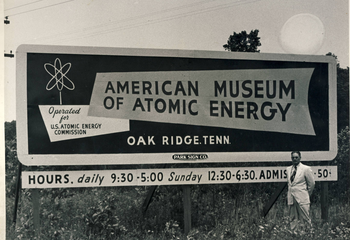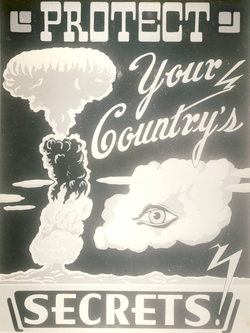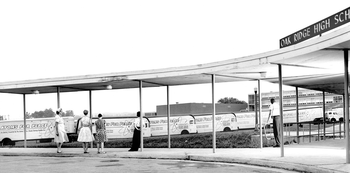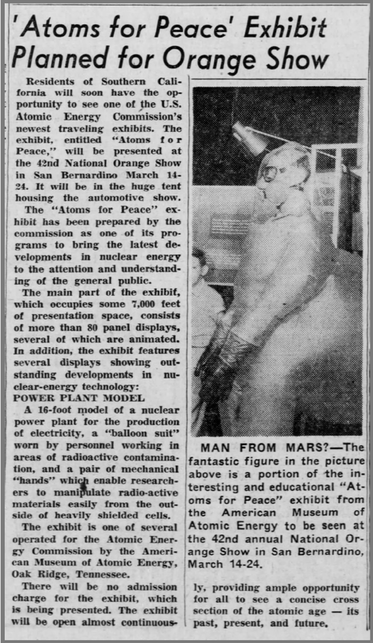"Atoms for Peace" Mobile Exhibits
(Los Angeles, 1957-1958)
 Photo courtesy of
Edward Dougherty at
www.secretcitythemovie.com.
Photo courtesy of
Edward Dougherty at
www.secretcitythemovie.com.
In 1949, the American Museum of Atomic Energy opened in
Oak Ridge, TN, to display the "peaceful uses" of atomic energy. Located in one of three secret cities in the United States, the museum opened the same year that the city was revealed to the public and placed on the map as "Oak Ridge". Previously known as the "Clinton Engineering Works" facilities, on a gated area covering 59,000 acres of land, employees were not told what they were working on. Posters plastered around the "city" constantly reminded the workers not to share what little they knew. Only when the area was renamed were the employees aware of their participation in the production of an atomic bomb.
Oak Ridge, TN, to display the "peaceful uses" of atomic energy. Located in one of three secret cities in the United States, the museum opened the same year that the city was revealed to the public and placed on the map as "Oak Ridge". Previously known as the "Clinton Engineering Works" facilities, on a gated area covering 59,000 acres of land, employees were not told what they were working on. Posters plastered around the "city" constantly reminded the workers not to share what little they knew. Only when the area was renamed were the employees aware of their participation in the production of an atomic bomb.
|
Using a diverse series of mobile exhibits, a 7,000 square foot display was erected at the Orange County Fair in January and at the National Orange Show in San Bernardino in March of 1957, including a Power Plant Model to show the progress made in the safe use of nuclear energy as a source of electricity. Temporary exhibits were also set up in Van Nuys, serving as a teaching aid for science classes at Notre Dame High School, and at the Encino Community Center. The more compact mobile van exhibit made short stops, such as in Long Beach, at the corner of 4th and Pine in January, 1958.
"Atoms for Peace" also popped up around the globe as an international traveling exhibit. Moving across continents, from South America to Europe and Asia, the exhibit served to inform both the government and public of the abilities that the United States held in safely harnessing and using nuclear energy. Starting in 1954 and lasting a few years, most of the time was spent distributing videos, pamphlets, and engaging in extensive media coverage to respond the Soviet Union's claim to also having the ability to develop and control nuclear energy. Disney's (1957) "Our Friend the Atom" video is one such example. International exhibits such as these would continue to serve as a main source for advertising, such as at conventions and at the World's Fairs in the U.S. and Europe. As an integral part of the Cold War, this type of propaganda kept the tensions high between the U.S. and the Soviet Union, but also involved the rest of the world in determining who would later be seen as the "victor." |
In 1978 the museum changed its name to the American Museum of Science and Energy (AMSE) and, even with its international reputation and significance, is having a difficult time in finding a sponsor and the necessary funds to remain open to the public. With a mission of "telling the story of Oak Ridge’s role in the Manhattan Project to build the first atomic bomb, showcasing the cutting-edge scientific and technical activities underway in Oak Ridge, and enhancing science education", the museum continues to serve as a leader of information on atomic and nuclear technological advances. As the Department of Energy loses interest in supporting this spread of knowledge about this town's history, which it essentially created, museums and the public alike will have to find a new way to experience the hands-on types of science that these exhibits once provided.



